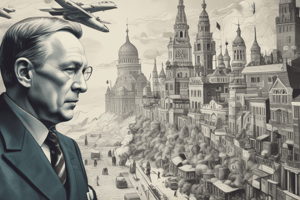Podcast
Questions and Answers
What is a primary characteristic of the bipolar international system during the Cold War era?
What is a primary characteristic of the bipolar international system during the Cold War era?
- A global government with a single authority
- A rivalry between three superpowers
- A rivalry between the United States and the Soviet Union (correct)
- A unipolar system with the United States as the sole superpower
What was a major internal weakness of the Soviet Union that contributed to the end of bipolarity?
What was a major internal weakness of the Soviet Union that contributed to the end of bipolarity?
- Strong economic growth and development
- International diplomatic recognition
- Rise of nationalist movements in the United States
- Economic stagnation and decline (correct)
What was a significant event that marked the symbolic end of the Cold War and division of Europe?
What was a significant event that marked the symbolic end of the Cold War and division of Europe?
- Dissolution of the Soviet Union
- Fall of the Berlin Wall (correct)
- Rise of China as a global power
- Gorbachev's reforms
What was a consequence of the end of bipolarity in terms of global governance and institutions?
What was a consequence of the end of bipolarity in terms of global governance and institutions?
What was a key factor in the rise of the United States as a sole superpower after the end of bipolarity?
What was a key factor in the rise of the United States as a sole superpower after the end of bipolarity?
What was a consequence of the end of bipolarity in terms of global power dynamics?
What was a consequence of the end of bipolarity in terms of global power dynamics?
What was the primary goal of the containment policy during the Cold War era?
What was the primary goal of the containment policy during the Cold War era?
What was the main outcome of the Helsinki Accords in 1975?
What was the main outcome of the Helsinki Accords in 1975?
What was a key consequence of Gorbachev's reforms in the 1980s?
What was a key consequence of Gorbachev's reforms in the 1980s?
What characterizes the shift from a bipolar to a multipolar world order?
What characterizes the shift from a bipolar to a multipolar world order?
What has been a key aspect of global governance in the post-Cold War era?
What has been a key aspect of global governance in the post-Cold War era?
What is a key feature of the new world order?
What is a key feature of the new world order?
What has been a consequence of the rise of new global actors in the post-Cold War era?
What has been a consequence of the rise of new global actors in the post-Cold War era?
What has been a key challenge in the post-Cold War era?
What has been a key challenge in the post-Cold War era?
Flashcards are hidden until you start studying
Study Notes
Definition and Context
- The end of bipolarity refers to the collapse of the bipolar international system that existed during the Cold War era (1945-1991)
- Characterized by a rivalry between two superpowers: the United States and the Soviet Union
Causes of the End of Bipolarity
- Internal weaknesses of the Soviet Union:
- Economic stagnation and decline
- Nationalist movements in Eastern Europe and Soviet republics
- Decline of communist ideology and loss of legitimacy
- External pressures:
- Military build-up and strategic competition with the United States
- Economic competition and globalization
- International pressure and diplomatic isolation
Key Events and Milestones
- Gorbachev's reforms (1985-1991):
- Introduction of glasnost (openness) and perestroika (restructuring)
- Democratization and decentralization of power
- Fall of the Berlin Wall (1989):
- Symbolic end of the Cold War and division of Europe
- Dissolution of the Soviet Union (1991):
- Formal end of the bipolar system and emergence of a new international order
Consequences of the End of Bipolarity
- Rise of the United States as a sole superpower:
- Unipolar moment and increased global influence
- New challenges and responsibilities
- Emergence of new global actors:
- Rise of regional powers and international organizations
- Shift towards multipolarity and complexity
- Changes in global governance and institutions:
- Reform and adaptation of international institutions
- Creation of new institutions and frameworks
Definition and Context
- The end of bipolarity refers to the collapse of the bipolar international system that existed during the Cold War era (1945-1991)
- Characterized by a rivalry between two superpowers: the United States and the Soviet Union
Causes of the End of Bipolarity
- Economic stagnation and decline of the Soviet Union contributed to its internal weaknesses
- Nationalist movements in Eastern Europe and Soviet republics eroded the Soviet Union's authority
- Decline of communist ideology and loss of legitimacy further weakened the Soviet Union internally
- Military build-up and strategic competition with the United States added to the external pressures
- Economic competition and globalization put additional strain on the Soviet economy
- International pressure and diplomatic isolation exacerbated the Soviet Union's difficulties
Key Events and Milestones
- Mikhail Gorbachev introduced glasnost (openness) and perestroika (restructuring) in 1985, aiming to democratize and decentralize power
- Gorbachev's reforms led to increased freedom and autonomy in Eastern Europe and Soviet republics
- The fall of the Berlin Wall in 1989 symbolized the end of the Cold War and division of Europe
- The Soviet Union was officially dissolved in 1991, marking the formal end of the bipolar system
Consequences of the End of Bipolarity
- The United States emerged as the sole superpower, with increased global influence and new challenges
- The rise of regional powers and international organizations led to a shift towards multipolarity
- Global governance and institutions underwent reforms and adaptations to address new challenges
- New institutions and frameworks were created to address emerging global issues
Cold War Era
- The period of Cold War (1945-1991) was marked by bipolarity, with the United States and the Soviet Union as the two superpowers.
- This era was characterized by intense rivalry, ideological competition, and geopolitical tensions.
- Features of the Cold War include mutual assured destruction (MAD) and nuclear deterrence, as well as proxy wars, espionage, and propaganda.
- The United States adopted a containment policy, while the Soviet Union promoted socialism and communism.
US-Soviet Relations
- The 1960s-1970s saw a period of détente, marked by the Strategic Arms Limitation Talks (SALT) and the Helsinki Accords (1975).
- However, détente collapsed in the late 1970s due to the Soviet invasion of Afghanistan and the US boycott of the Moscow Olympics.
- In the 1980s, Gorbachev's reforms, including glasnost (openness) and perestroika (restructuring), led to the decline of Soviet influence and eventual collapse.
Rise of Multipolarity
- The end of the Cold War marked the beginning of a multipolar world order, with the emergence of new global actors.
- These actors include Europe (EU), China, Japan, India, and Brazil.
- The shift from a two-superpower system to a more complex, multi-actor system has increased global complexity.
Impact on Global Governance
- The end of the Cold War led to changes in global governance structures and institutions.
- The United Nations has increased in relevance and importance, while international organizations like the World Trade Organization (WTO), International Monetary Fund (IMF), and World Bank have grown in influence.
- Regional organizations and agreements, such as the EU and ASEAN, have also emerged.
- New challenges and opportunities for global cooperation have arisen, including climate change, nuclear proliferation, and economic interdependence.
Emergence of New World Order
- The new world order is characterized by multipolarity, diversity of global actors, and increased economic interdependence.
- The shift from ideological to pragmatic competition has led to the emergence of non-state actors, such as NGOs and multinational corporations.
- There is ongoing debate and uncertainty about the nature and direction of the new world order, including concerns about American hegemony, the role of international institutions, and the need for new forms of cooperation and collective leadership.
Studying That Suits You
Use AI to generate personalized quizzes and flashcards to suit your learning preferences.




